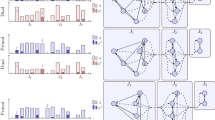Abstract
We present complexity results on solving real-number standard linear programs LP(A,b,c), where the constraint matrix  the right-hand-side vector
the right-hand-side vector  and the objective coefficient vector
and the objective coefficient vector  are real. In particular, we present a two-layered interior-point method and show that LP(A,b,0), i.e., the linear feasibility problem A
x = b and x ≥ 0, can be solved in in O(n
2.5
c(A)) interior-point method iterations. Here 0 is the vector of all zeros and c(A) is the condition measure of matrix A defined in [25]. This complexity iteration bound is reduced by a factor n from that for general LP(A, b, c) in [25]. We also prove that the iteration bound will be further reduced to O(n
1.5
c(A)) for LP(A, 0, 0), i.e., for the homogeneous linear feasibility problem. These results are surprising since the classical view has been that linear feasibility would be as hard as linear programming.
are real. In particular, we present a two-layered interior-point method and show that LP(A,b,0), i.e., the linear feasibility problem A
x = b and x ≥ 0, can be solved in in O(n
2.5
c(A)) interior-point method iterations. Here 0 is the vector of all zeros and c(A) is the condition measure of matrix A defined in [25]. This complexity iteration bound is reduced by a factor n from that for general LP(A, b, c) in [25]. We also prove that the iteration bound will be further reduced to O(n
1.5
c(A)) for LP(A, 0, 0), i.e., for the homogeneous linear feasibility problem. These results are surprising since the classical view has been that linear feasibility would be as hard as linear programming.
Similar content being viewed by others
References
Bayer, D.A., Lagarias, J.C.: The nonlinear geometry of linear programming. II. Legendre transform coordinates and central trajectories. Transactions of the AMS 314, 527–581 (1989)
Blum, L., Cucker, F., Shub, M., Smale, S.: Complexity and Real Computation (Springer-Verlag, 1996)
Forsgren, A.: On linear least-squares problems with diagonally dominant weight matrices. SIAM J. Matrix Anal. Appl. 17, 763–788 (1996)
Fruend, R.M., Vera, J.R.: Some characterization and properties of the “distance to ill-posedness” and the condition measures of a conic linear system. Math. Program. 86, 225–260 (1999)
Gonzaga, C.C.: Path-following methods for linear programming. SIAM Review 34, 167–224 (1992)
Gonzaga, C.C., Lara, H.J.: A note on properties of condition numbers. Department of Mathematics, Federal University of Santa Catarina, Cx. Postal 5210, 88040-970 Florianopolis, SC, Brazil, 1996
Ho, J.C.K., Tuncel, L.: Reconciliation of various complexity and condition measures for linear programming problems and a generalization of Tardos' theorem. Foundations of computational mathematics, Proceedings of the Smalefest, World Scientific, 2002, pp. 93–147
Karmarkar, N.: A new polynomial-time algorithm for linear programming. Combinatorica 4, 373–395 (1984)
Khachiyan, L.G.: A polynomial algorithm in linear programming. Dokl. Akad. Nauk SSSR 244, 1093–1086 (1979); Translated in Soviet Math. Dokl. 20, pp. 191–194
Kojima, M., Mizuno, S., Yoshise, A.: A polynomial-time algorithm for a class of linear complementarity problems. Math. Program. 44, 1–26 (1989)
Megiddo, N.: Pathways to the optimal set in linear programming. In: Progress in Mathematical Programming: Interior Point and Related Method, N. Megiddo (ed.), (Springer, New York, 1989) pp. 131–158
Megiddo, N., Mizuno, S., Tsuchiya, T.: A modified layered-step interior-point algorithm for linear programming. Math. Program. 82, 339–356 (1998)
Mizuno, S., Todd, M.J., Ye, Y.: On adaptive-step primal-dual interior-point algorithms for linear programming. Math. Oper. Res. 18, 964–981 (1993)
Monteiro, R.C., Adler, I.: Interior path following primal-dual algorithm. Part I: linear programming. Math. Program. 44, 27–41 (1989)
Monteiro, R.C., Tsuchiya, T.: A variant of the Vavasis-Ye layered-step interior-point algorithm for linear programming. SIAM J. Optimization 13, 1054–1079 (2003)
Monteiro, R.C., Tsuchiya, T.: A new iteration-complexity bound for the MTY predictor-corrector algorithm, Research Memorandom No. 856, The Inistitute of Statistical Mathematics, Tokyo, Japan, October 2002
Papadimitriou, C.H., Steiglitz, K.: Combinatorial Optimization: Algorithms and Complexity (Prentice Hall, Englewood Cliffs, New Jersey, 1982)
Renegar, J.: A polynomial-time algorithm based on Newton's method for linear programming. Math. Program. 40, 59–94 (1988)
Renegar, J.: Linear programming, complexity theory, and elementary functional analysis. Math. Program. 70, 279–351 (1995)
Sonnevend, G., Stoer, J., Zhao, G.: On the complexity of following the central path of linear programs by linear extrapolation II. Math. Program. 52, 527–553 (1991)
Stewart, G.W.: On scaled projections and pseudoinverses. Linear Algebra and its Applications 112, 189–193 (1989)
Todd, M.J.: A Dantzig-Wolfe-like variant of Karmarkar's interior-point linear programming algorithm. Oper. Res. 38, 1006–1018 (1990)
Todd, M.J., Tuncel, L., Ye, Y.: Probabilistic analysis of two complexity measures for linear programming problems. Math. Program. 90, 59–69 (2001)
Vavasis, S.A., Ye, Y.: A simplification to “A primal-dual interior-point method whose running time depends only on the constraint matrix,” H. Frenk et al., High Performance Optimization (Kluwer Academic Publishers, 2000), pp. 233–265
Vavasis, S., Ye, Y.: A primal-dual interior-point method whose running time depends only on the constraint matrix. Math. Program. 74, 79–120 (1996)
Vavasis, S., Ye, Y.: Identifying an optimal basis in linear programming. Annals Oper. Res. 62, 565–572 (1996)
Ye, Y.: On the finite convergence of interior-point algorithms for linear programming. Math. Program. 57, 325–335 (1992)
Author information
Authors and Affiliations
Corresponding author
Additional information
This author was supported in part by NSF Grants DMS-9703490 and DMS-0306611
Rights and permissions
About this article
Cite this article
Ye, Y. Improved complexity results on solving real-number linear feasibility problems. Math. Program. 106, 339–363 (2006). https://doi.org/10.1007/s10107-005-0610-7
Received:
Accepted:
Published:
Issue Date:
DOI: https://doi.org/10.1007/s10107-005-0610-7




